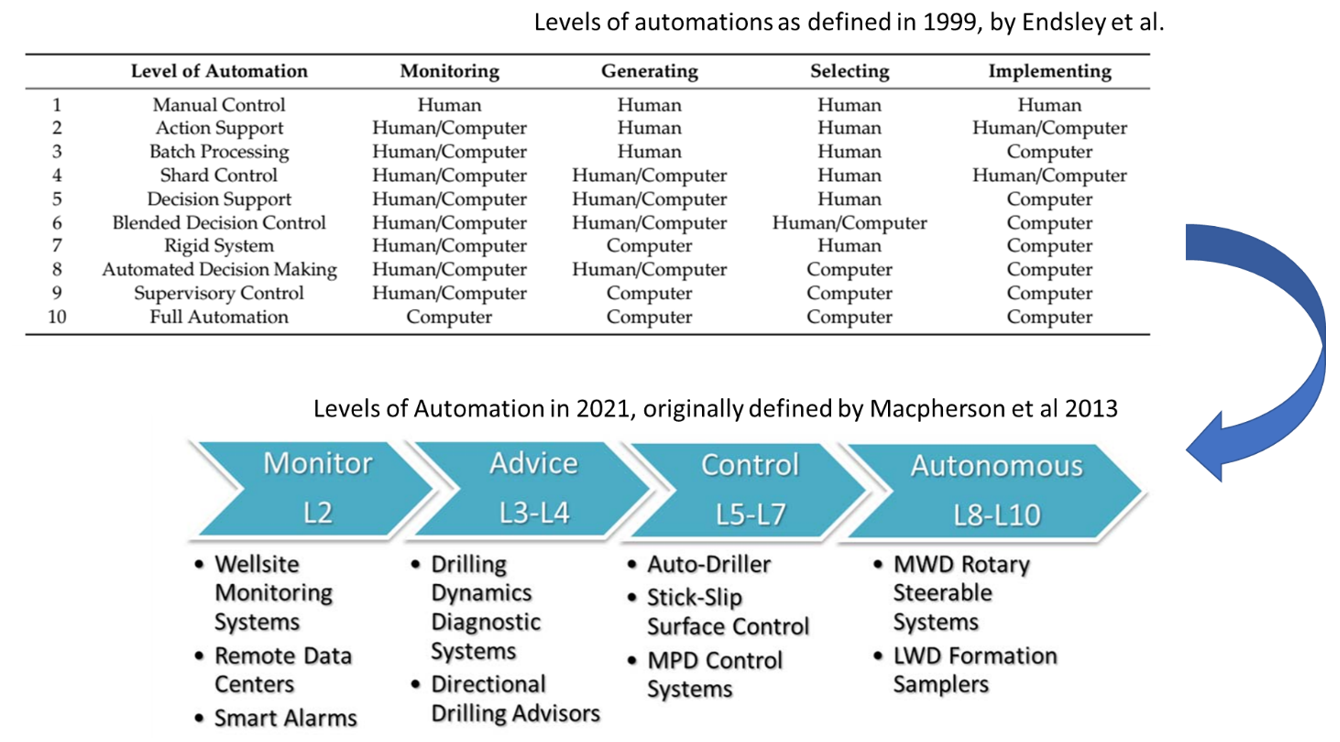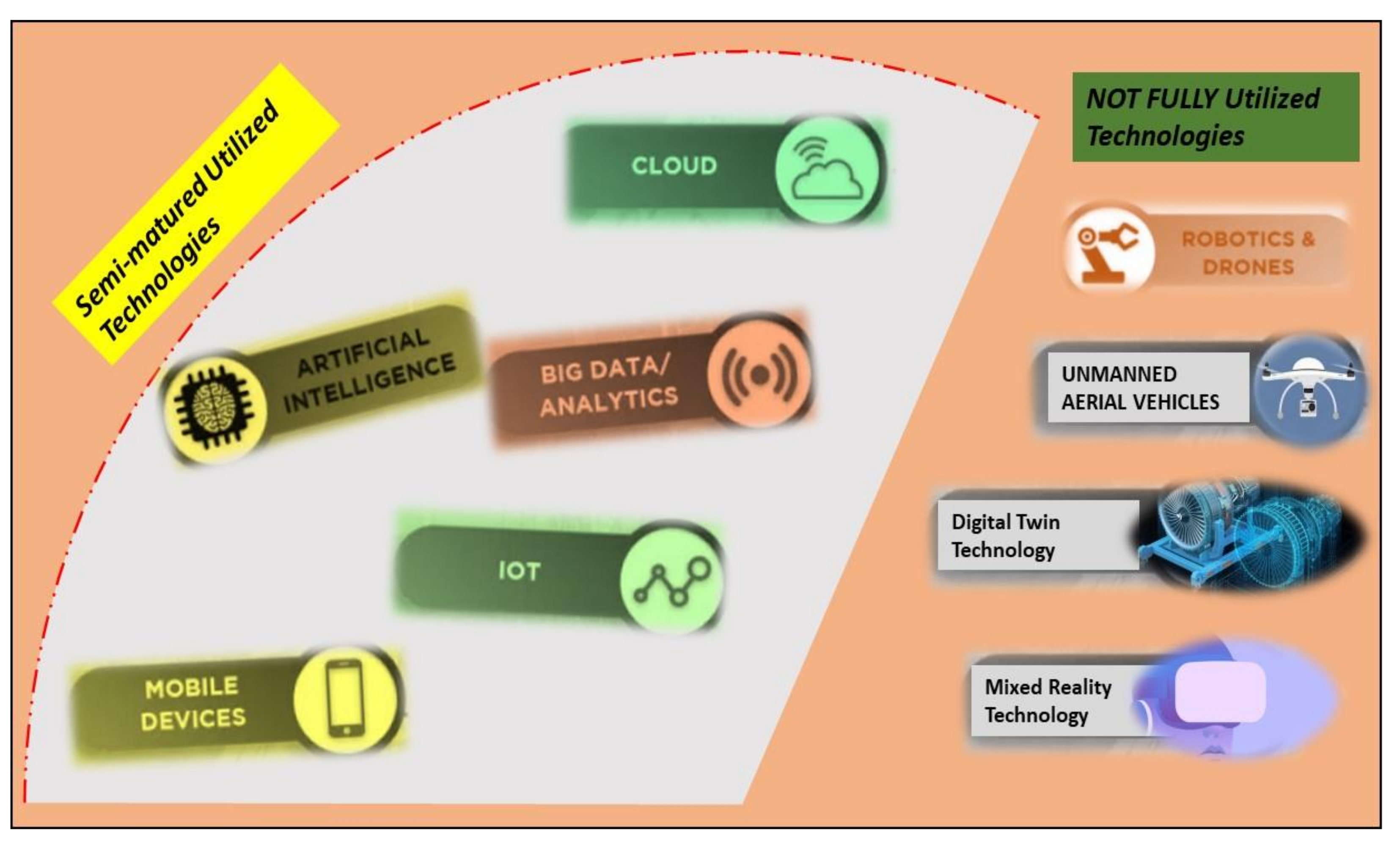An Outlook of Drilling Technologies and Innovations: Present Status and Future Trends
Abstract
:1. Introduction
2. Enabled Drilling Performance through Advancing Systems and Technologies
2.1. Company Enabled Drilling Solutions
2.2. Academic Research-Enabled Drilling Solutions
2.3. Other Next-Generation Ideas That Affect Drilling
3. Unconventional Solutions: Bridging the Gaps and Catalyst for Change
4. Conclusions
Author Contributions
Funding
Institutional Review Board Statement
Informed Consent Statement
Conflicts of Interest
Nomenclature
| BHA | Bottomhole Assembly |
| MPD | Managed Pressure Drilling |
| MWD | Measurement While Drilling |
| WITSML | Well-Site Information Transfer Standard Markup Language |
| RSS | Rotary Steerable System |
References
- Menand, S. Technology Focus: Horizontal and Extended-Reach Wells. J. Pet. Technol. 2019, 71, 61. [Google Scholar] [CrossRef]
- Aadnøy, B.S. Technology Focus: Multilateral/Extended-Reach Wells. J. Pet. Technol. 2018, 70, 65. [Google Scholar] [CrossRef]
- Buntoro, A. Casing Drilling Technology as the Alternative of Drilling Efficiency. In Proceedings of the IADC/SPE Asia Pacific Drilling Technology Conference and Exhibition, Jakarta, Indonesia, 25–27 August 2008. [Google Scholar] [CrossRef]
- Ma, T.; Chen, P.; Zhao, J. Overview on Vertical and Directional Drilling Technologies for the Exploration and Exploitation of Deep Petroleum Resources. Geomech. Geophys. Geo-Energy Geo-Resour. 2016, 2, 365–395. [Google Scholar] [CrossRef] [Green Version]
- Bello, O.; Teodoriu, C.; Holzmann, J.; Yaqoob, T. Application of Artificial Intelligence Methods in Drilling System Design and Operations: A Review of the State of the Art. J. Artif. Intell. Soft Comput. Res. 2015, 5, 121–139. [Google Scholar] [CrossRef] [Green Version]
- Bello, O.; Srivastava, S.; Teodoriu, C.; Okech, R.R. Conference Proceedings. In Proceedings of the First EAGE Workshop on Geothermal Energy and Hydro Power in Africa, online, 7–9 December 2020; Volume 2020, pp. 1–5. [Google Scholar] [CrossRef]
- Available online: https://www.prnewswire.com/news-releases/automation-in-oil-rigs-to-have-strong-impact-on-oil-and-gas-extraction-businesses--discover-company-insights-for-the-oil-and-gas-extraction-industry--bizvibe-301273006.html (accessed on 28 April 2021).
- Todd, F. World First: Profiling Equinor’s Fully Automated Oil and Gas Platform in the North Sea. Available online: https://www.nsenergybusiness.com/features/first-automated-oil-gas-platform (accessed on 17 June 2021).
- Bureau Veritas. Available online: https://marine-offshore.bureauveritas.com/magazine/autonomous-future-offshore-platforms (accessed on 17 June 2021).
- Available online: https://www.nov.com/products/drilling-control-systems-and-rig-automation (accessed on 23 April 2021).
- Ghamdi, A.; Meshal, A. IoT in Offshore Operations: Business Implications and Opportunities. In Proceedings of the Abu Dhabi International Petroleum Exhibition & Conference, Abu Dhabi, United Arab Emirates, 9–12 November 2020. [Google Scholar] [CrossRef]
- Endsley, M.R.; Kaber, D.B. Level of Automation Effects on Performance, Situation Awareness and Workload in a Dynamic Control Task. Ergonomics 1999, 42, 462–492. [Google Scholar] [CrossRef] [Green Version]
- Macpherson John, D.; de Wardt John, P.; Florence, F.; Chapman Clinton, D.; Zamora, M.; Laing Moray, L.; Fionn, P.I. Drilling Systems Automation: Current State, Initiatives and Potential Impact. In Proceedings of the SPE Annual Technical Conference and Exhibition, New Orleans, LA, USA, 30 September–2 October 2013. [Google Scholar] [CrossRef]
- Cayeux, E.; Daireaux, B.; Ambrus, A.; Mihai, R.; Carlsen, L. Autonomous Decision-Making While Drilling. Energies 2021, 14, 969. [Google Scholar] [CrossRef]
- Creegan, A.; Jeffery, C. Adaptive Drilling Application uses AI to Enhance On-Bottom Drilling Performance. J. Pet. Technol. 2020, 72, 45–47. [Google Scholar]
- Available online: https://www.drillingcontractor.org/ (accessed on 21 April 2021).
- Available online: https://www.enteq.com/products/rotary-steerable-system-srss/ (accessed on 21 April 2021).
- Available online: https://www.oedigital.com/news/466176-push-the-bit-rss (accessed on 20 April 2021).
- Available online: https://www.bakerhughes.com/sites/bakerhughes/files/2021-01/i-Trak-drilling-automation-services-slsh.pdf (accessed on 29 April 2021).
- Forester, S. Better Understanding of Data, Physics Key to BHA Optimization. Available online: https://www.drillingcontractor.org/better-understanding-of-data-physics-key-to-bha-optimization-59510 (accessed on 16 June 2021).
- Available online: https://www.slb.com/drilling/surface-and-downhole-logging/measurements-while-drilling-services/optidrill-bha-monitoring-service (accessed on 21 April 2021).
- Available online: https://www.worldoil.com/company-news/2021/1/1/safe-influx-granted-patent-for-novel-automated-well-control-technology (accessed on 21 April 2021).
- Available online: https://www.drillingcontractor.org/safe-influx-granted-patent-for-novel-automated-well-control-system-59148 (accessed on 21 April 2021).
- Available online: https://www.oilfieldtechnology.com/drilling-and-production/09042021/rig-trial-of-integration-of-mpd-and-automated-well-control-technology-completed/ (accessed on 22 April 2021).
- Sharma, A.; Srivastava, S.; Teodoriu, C. Experimental Design, Instrumentation, and Testing of a Laboratory-Scale Test Rig for Torsional Vibrations—The Next Generation. Energies 2020, 13, 4750. [Google Scholar] [CrossRef]
- Braga, C.D.; Kamyab, M.; Brian, H.; Joshi, D. Combining Live Drilling Data Stream with a Cloud Data Analytics Pipeline to Perform Real-Time Automated Projections to the Bit. In Proceedings of the SPE/IADC International Drilling Conference and Exhibition, Virtual, 8 March 2021. [Google Scholar] [CrossRef]
- Koc, S.; Dahi Taleghani, A. A Fast Method to Determine the Critical Depth of Cut for Various Rock Types. Energies 2020, 13, 4496. [Google Scholar] [CrossRef]
- Nystad, M.; Aadnøy, B.S.; Pavlov, A. Real-Time Minimization of Mechanical Specific Energy with Multivariable Extremum Seeking. Energies 2021, 14, 1298. [Google Scholar] [CrossRef]
- Thakur, B.; Robello, S. Deep Learning for Downhole Data Prediction: A Cost-Effective Data Telemetry Through Data Analytics. In Proceedings of the SPE Western Regional Meeting, Virtual, 20–22 April 2021. [Google Scholar] [CrossRef]
- Dumitrescu, A.; Minescu, M.; Dinita, A.; Lambrescu, I. Corrosion Repair of Pipelines Using Modern Composite Materials Systems: A Numerical Performance Evaluation. Energies 2021, 14, 615. [Google Scholar] [CrossRef]
- Sliwa, T.; Jarosz, K.; Rosen, M.A.; Sojczyńska, A.; Sapińska-Śliwa, A.; Gonet, A.; Fąfera, K.; Kowalski, T.; Ciepielowska, M. Influence of Rotation Speed and Air Pressure on the Down the Hole Drilling Velocity for Borehole Heat Exchanger Installation. Energies 2020, 13, 2716. [Google Scholar] [CrossRef]
- Fang, Q.; Meng, Y.; Wei, N.; Xu, C.; Li, G. A Hydraulic Model for Multiphase Flow Based on the Drift Flux Model in Managed Pressure Drilling. Energies 2019, 12, 3930. [Google Scholar] [CrossRef] [Green Version]
- Kimanzi, R.; Patel, H.; Khalifeh, M.; Salehi, S.; Teodoriu, C. Potentials of Nano-Designed Plugs: Implications for Short and Long Term Well Integrity. In Proceedings of the ASME 2019 38th International Conference on Ocean, Offshore and Arctic Engineering, Scotland, UK, 9–14 June 2019; Volume 8: Polar and Arctic Sciences and Technology. Petroleum Technology. [Google Scholar]
- Kiran, R.; Teodoriu, C.; Dadmohammadi, Y.; Nygaard, R.; Wood, D.; Mokhtari, M.; Salehi, S. Identification and Evaluation of Well Integrity and Causes of Failure of Well Integrity Barriers (A Review). J. Nat. Gas Sci. Eng. 2017, 45, 511–526. [Google Scholar] [CrossRef]
- Kremieniewski, M. Influence of Graphene Oxide on Rheological Parameters of Cement Slurries. Energies 2020, 13, 5441. [Google Scholar] [CrossRef]
- Eltsov, T.; Patzek, T.W. Beyond Carbon Steel: Detecting Wellbore Shape and Cavities, and Cement Imperfections in Cased Wells. Energies 2019, 12, 4211. [Google Scholar] [CrossRef] [Green Version]
- Ahmed, S.; Patel, H.; Salehi, S.; Ahmed, R.; Teodoriu, C. Performance Evaluation of Liner Dual Barrier System in CO2-Rich Geothermal Wells. Geothermics 2016, 95, 120121. [Google Scholar]
- Konsta, M.; Metaxa, Z.; Shah, S. Multi-scale Mechanical and Fracture Characteristics and Early-Age Strain Capacity of High-Performance Carbon Nanotube/Cement Nanocomposites. Cem. Concr. Comp. 2010, 32, 110–115. [Google Scholar] [CrossRef]
- Ranjbartoreh, A.; Wang, B.; Shen, X.; Wang, G. Advanced mechanical properties of graphene paper. J. Appl. Phys. 2011, 109, 014306. [Google Scholar] [CrossRef]
- Kasiralvalad, E. The great potential of nanomaterials in drilling & drilling fluid applications. Int. J. Nano Dimens. 2014, 5, 463–471. [Google Scholar]
- Arbad, N.; Teodoriu, C. A Review of Recent Research on Contamination of Oil Well Cement with Oil-based Drilling Fluid and the Need of New and Accurate Correlations. ChemEnginerring 2020, 4, 28. [Google Scholar] [CrossRef] [Green Version]
- Arbad, N.; Rincon, F.; Teodoriu, C.; Amani, M. Experimental investigation of deterioration in mechanical properties of oil-based mud (OBM) contaminated API cement slurries & correlations for ultrasonic cement analysis. J. Pet. Sci. Eng. 2021, 205, 108909. [Google Scholar]
- Hurtado, J. 2019. Available online: https://www.prescouter.com/2019/05/key-technologies-advancing-oil-and-gas-drilling/ (accessed on 29 April 2021).


| Author | Technology | Comments |
|---|---|---|
| Endsley et al. (1999) | Definition of autonomous drilling | This is the first accepted version of a definition for autonomous drilling |
| Macpherson et al. (2013) | Upgrading the autonomous drilling definition and steps forward | This is the most accepted approach by the industry toward automated drilling systems |
| Cayeux et al. (2021) | Proposes an autonomous drilling algorithm | A complex autonomous drilling algorithm is presented |
| Creegan and Jeffrey (2020) | Intelligent drilling optimization application performs as an adaptive autodriller | This is the introduction of the autodriller using recent optimization techniques |
| oedigital article (2019), Enteq, Baker, Schlumberger, | Various rotary steerable systems are introduced with an autonomous mode | The current market is dominated by the low-cost high-performance RSS with autonomous options |
| Sharma et al. (2020) | Instrumentational laboratory-scale test rig (stick-slip simulator) | A mechatronic integration in a unique experimental setup to understand and mitigate stick-slip situations at the bit |
| Braga et al. (2021) | Predicts bit in real time with 30 s updates using WITMSL data | A very useful integration of real-time data at rig site with bit predictive software package |
| Koc and Taleghani (2020) | Estimates the critical depth of cut (DOC) of different rock specimens | The proposed method can be integrated in ROP evaluation software package and will help in understanding when bit wear is high |
| Nystad et al. (2021) | Application of a data-driven optimization method called extremum seeking (ES) | Best applicable to improve safety of drilling process |
| Thakur and Samuel (2021) | Predict downhole data by employing deep learning using surface data | Focused on improving rate of penetration |
| Dumitrescu et al. (2021) | Corrosion repair of pipelines using a modern composite materials system | Proposed experimental and numerical work to estimate the repair quality of composite repair systems |
| Sliwa et al. (2020) | Understanding of the impact of rotational speed, drill bit diameter, and air pressure on drilling velocity for the down-the-hole (DTH) drilling method | The method is useful to better define automated downhole hammer drilling processes |
| Fang et al. (2019) | Development of an MPD wellbore transient flow dynamic model | Better prediction of MPD and helping in automated MPD control |
Publisher’s Note: MDPI stays neutral with regard to jurisdictional claims in published maps and institutional affiliations. |
© 2021 by the authors. Licensee MDPI, Basel, Switzerland. This article is an open access article distributed under the terms and conditions of the Creative Commons Attribution (CC BY) license (https://creativecommons.org/licenses/by/4.0/).
Share and Cite
Teodoriu, C.; Bello, O. An Outlook of Drilling Technologies and Innovations: Present Status and Future Trends. Energies 2021, 14, 4499. https://doi.org/10.3390/en14154499
Teodoriu C, Bello O. An Outlook of Drilling Technologies and Innovations: Present Status and Future Trends. Energies. 2021; 14(15):4499. https://doi.org/10.3390/en14154499
Chicago/Turabian StyleTeodoriu, Catalin, and Opeyemi Bello. 2021. "An Outlook of Drilling Technologies and Innovations: Present Status and Future Trends" Energies 14, no. 15: 4499. https://doi.org/10.3390/en14154499







